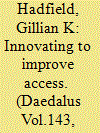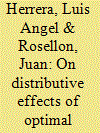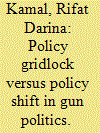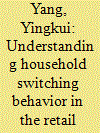|
|
|
Sort Order |
|
|
|
Items / Page
|
|
|
|
|
|
|
| Srl | Item |
| 1 |
ID:
163914


|
|
|
|
|
| Summary/Abstract |
The weakness of the antigun lobby in the United States is attributed to the “collective action problem” of trying to mobilize “free riders” behind a public purpose. But the Coalition for Gun Control emerged in Canada to successfully lobby for the Firearms Act of 1995. If the “collective action problem” is not limited to the United States, then are its effects “mediated” by political culture? To address this research question, we content analyze (1) media coverage, (2) party platforms, (3) presidential, and (4) ministerial rhetoric. Three frames represent “restrictive” gun policies that ban or regulate firearms, “punitive” gun policies that penalize the person for the unlawful use of firearms, or “lenient” gun policies that encourage gun ownership and gun rights. Marked differences in framing the gun debate help explain why an antigun coalition emerged in Canada but not the United States.
|
|
|
|
|
|
|
|
|
|
|
|
|
|
|
|
| 2 |
ID:
127910


|
|
|
|
|
| Publication |
2014.
|
| Summary/Abstract |
To cope with the excessive growth of energy consumption, the Chinese government has been trying to strengthen the energy regulation system by introducing new initiatives that aim at controlling the total amount of energy consumption. A partial frontier analysis is performed in this paper to make a comparative assessment of the combinations of possible energy conservation objectives, new constraints and regulation strategies. According to the characteristics of the coordination of existing regulation structure and the optimality of regulation strategy, four scenarios are constructed and regional responsibilities are reasonably divided by fully considering the production technology in the economy. The relative importance of output objectives and the total amount controlling is compared and the impacts on the regional economy caused by the changes of regulation strategy are also evaluated for updating regulation policy.
|
|
|
|
|
|
|
|
|
|
|
|
|
|
|
|
| 3 |
ID:
132719


|
|
|
|
|
| Publication |
2014.
|
| Summary/Abstract |
The EU 7th Framework Project FAST20XX [1] aimed to enlarge the foundations of suborbital high-speed transportation in a wide variety of fields. One of the key issues of this project was to outline a desirable regulatory framework that would best serve the interests of all European stakeholders in this new activity.
The US Federal Aviation Administration (FAA) has issued a series of requirements for operators of commercial suborbital flights under the 2004 Commercial Space Launch Amendments Act (CSLAA), enabling the corresponding market to develop. These regulations were initially valid until 2012 but have now been extended until 2015.
In Europe, practical and successful attempts to fly experimental vehicles of this kind do not yet exist. However, several developments indicate that it is becoming urgent to pay attention to this potential new industry and find ways to regulate it in a safe yet flexible manner. Although the European Aviation Safety Agency (EASA) explored the possibility in 2008 to prepare for a certification approach under the concept of "Suborbital Aeroplanes" (SoA), this initiative was put on hold in 2011, and a final decision by the European Commission is still pending.
This paper highlights some of the research performed by the authors towards the establishment of a roadmap for future regulation of suborbital flight in Europe. In particular, it will present results of a survey carried out among stakeholders, including operators and manufacturers of vehicles, spaceports, national and European regulators, insurers and brokers, consultants, users and lobbyists. The paper also presents results from the workshop on the future regulatory framework for suborbital flights in Europe, which was co-organised by the present authors and held in Brussels in October 2012.
|
|
|
|
|
|
|
|
|
|
|
|
|
|
|
|
| 4 |
ID:
132755


|
|
|
|
|
| Publication |
2014.
|
| Summary/Abstract |
Struggling to navigate a world that is increasingly shaped by legal rules and obligations, most ordinary Americans lack real access to courts. Often this means simply forgoing legal rights and entitlements or giving up in the face of claims of wrongdoing. Among those who cannot avoid courts-such as those facing eviction, collection, or foreclosure and those seeking child support, custodial access, or protection from violence or harassment-the vast majority (as many as 99 percent in some cases) find themselves in court without any legal assistance at all. There are many reasons for this lack of meaningful access, including the underfunding of courts and legal aid, but perhaps the most fundamental is the excessively restrictive American approach to regulating legal markets. This regulation, controlled by the American legal profession and judiciary, closes off the potential for significant reductions in the cost of, and hence increases in access to, courts. Unlike the problem of funding, that is a problem that state courts have the power, if they can find the judicial will, to change.
|
|
|
|
|
|
|
|
|
|
|
|
|
|
|
|
| 5 |
ID:
168063


|
|
|
|
|
| Summary/Abstract |
In health care markets, moral hazard is conventionally viewed as a demand-side phenomenon in which insurance causes patients to use more care because it reduces the price they have to pay for care. However, demand-side moral hazard cannot explain why U.S. per capita health care costs are much higher than those of countries with universal coverage and lower out-of-pocket charges. Instead, blame rests with a phenomenon that may be called supply-side moral hazard, which occurs when third-party payment removes the constraints the demand curve would otherwise exert over the prices providers charge, and the quantity of expensive services they can sell. Public institutions are better positioned than private entities to address supply-side moral hazard. This helps explain why the other wealthy democracies—both those with single-payer systems, like Canada, and those with multipayer systems and all-payer procedures for setting provider rates, like Germany and Switzerland—spend much less per capita than the United States. Although managed care achieved some success in controlling U.S. provider prices in the 1990s, in the longer term, it motivated increasing market concentration among providers, which vitiated cost control. Furthermore, managed care exacerbates inequity and complexity, problems that public price regulation avoids.
|
|
|
|
|
|
|
|
|
|
|
|
|
|
|
|
| 6 |
ID:
132654


|
|
|
|
|
| Publication |
2014.
|
| Summary/Abstract |
To date, the distributive implications of incentive regulation on electricity transmission networks have not been explicitly studied in the literature. More specifically, the parameters that a regulator might use to achieve distributive efficiency under price-cap regulation have not yet been identified. To discern these parameters is the motivation for the research presented in this paper. We study how different weight parameters affect the distributive characteristics of optimal price-cap incentive regulation for electricity transmission. We find that a regulator×s use of ideal (Laspeyres) weights tends to be more beneficial for the Transco (consumers) than for consumers (the Transco).
|
|
|
|
|
|
|
|
|
|
|
|
|
|
|
|
| 7 |
ID:
163913


|
|
|
|
|
| Summary/Abstract |
Why do major events of gun violence (i.e., mass shootings) lead to incremental change or no federal legislative change at all in the United States while major events of gun violence have resulted in large-scale legislative changes in Canada? Exploring the complexities involved in this compelling question, this article conducts a comparative analysis of recent gun control policy gridlock and shift in these two countries. We concentrate on two mass shooting cases in each country: the Columbine (1990) and Sandy Hook (2012) massacres in the United States and the École Polytechnique Massacre (1989) and Concordia Shooting (1992) in Canada. We use veto player theory to gain insights into why tightening gun policy is so difficult to implement in the United States while Canada often follows up with policy transformations after a focusing event. This theory informs the central argument that the key factors underpinning the divergent policy outcomes on gun control issues in both countries involve differences in the structure of government/institutional design and the role and power of interest groups in each case.
|
|
|
|
|
|
|
|
|
|
|
|
|
|
|
|
| 8 |
ID:
132675


|
|
|
|
|
| Publication |
2014.
|
| Summary/Abstract |
Deregulation of the Danish retail electricity market nearly a decade ago has produced little consumer switching among suppliers or renegotiation of supplier service contracts. From an energy policy perspective, a certain amount of supplier switching is an important indicator of the success of market deregulation. This argues that poor relationship management and a lack of economic benefits are two critical barriers to consumer switching. Latent class analysis indicates that only 11.4% of consumers are non-switchers, whereas 41.1% can be considered potential switchers and approximately one-half (47.5%) can be considered apathetic consumers. We also discuss the managerial implications for both electricity suppliers and policy makers.
|
|
|
|
|
|
|
|
|
|
|
|
|
|
|
|
|
|
|
|
|